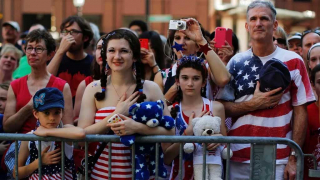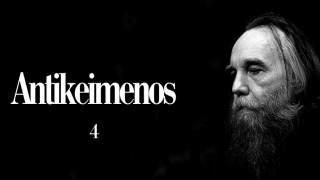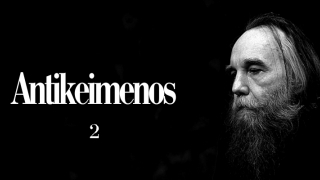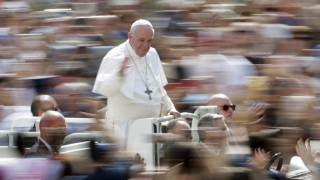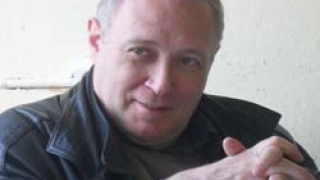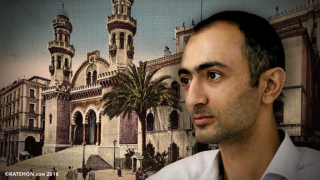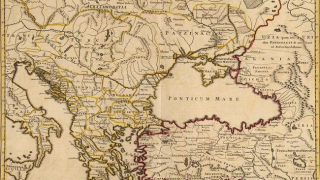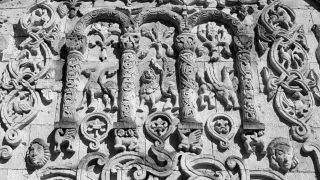The Role of Relics in America
Sacred relics have often been a unifying force in pre-Modern societies. The Western historian Christopher Dawson relates one account of this phenomenon from Uganda:
‘Moreover in Ankole, at least, the state cult of Bagyendwana, the royal drums, which are the national fetish or palladium, transcends the distinction of classes and castes. The serfs as well as the nobles can bring their offerings to Bagyendwana and appeal to it for justice. For all the peoples of Ankole are “the children of Bagyendwana” “who is like the king only greater. For the king is the servant of Bagyendwana” (Religion and Culture, Washington, D. C., Catholic U of America Press, 2013 [1948], p. 151)’.
Here in the States, an attempt was made at creating this sort of transcendent, unifying, sacred object. The result has been a series of documents spelling out the revolutionary propositions the ‘American experiment’ is based upon: the Mayflower Compact, the Declaration of Independence, the Constitution of 1787 and its later amendments (the Bill of Rights, etc.), and the Gettysburg Address.
All of these have proven quite useless at attaining the desired end, but this should have been the expected result all along. When one embraces the Gnostic notions of a divine individual whose own subjective experiences shape his beliefs about truth and reality, and whose personal sovereignty allows him to be in or out of the political order as his whim dictates (all principles which flow from these documents to one degree or another), then there will necessarily be a great variety of interpretations of the texts and the lessons we should draw from them regarding societal organization, morality, etc.
Said another way, when an object is sacred because of a deifying force outside of itself and outside of the will of man acting alone, that is, because it is united with the Divine, then it will have the power to overcome the divisions that beset the men and women of a tribe, country, etc. But when sinful men who believe they are holy try to impart that imaginary holiness to an object, as the ‘demi-gods’ (Thomas Jefferson’s word) did, for example, when meeting in Philadelphia to craft the 1787 governing charter, it will be an utter failure at encouraging the oneness of the people.
What will result is what we are seeing come to pass in the States year after year, i.e., more and more strands of individual or group identity: conservative, liberal, libertarian, socialist, straight, gay, trans, and on and on. The latest era of ‘divided government’ in Washington City and throughout the various States is part of this ongoing process; and so too is the tremendous divide in dozens of cities between the racist BLM/Antifa rioters and those seeking some semblance of a peaceful life.
This counterfeit Political Church of America has thus shown its uselessness and harmfulness once again. The contrast with the experience of the Orthodox Church could not be greater. But what does that look like, particularly as it regards holy relics and the unity of peoples?
First, we should note what makes the relics of the saints so important for Orthodox Christians. St Justin Popovich of Serbia (+1979) writes,
‘Everyone and all are set on their mystical path toward God, toward the God-Man. Inasmuch as it was created by God, the Logos, matter possesses this same theocentricity. Moreover, by His advent into our earthly world, by His all-embracing condescension as God and Man for the redemption of the world, the Lord Christ clearly demonstrated that not only the soul, but matter also was created by God and for God, and that He is God and Man; and for it, matter, He is all and everything in the same manner as for the soul. Being created by God, the Logos, matter is, in its innermost core, God-longing and Christ-longing.
‘The most obvious proof of this is the fact that God the Word has become Incarnate, has become man (St. John 1:14). By His Incarnation, matter has been magnified with Divine glory and has entered into the grace- and virtue-bestowing, ascetic aim of deification, or union with Christ. God has become flesh, has become human, so that the entire man, the entire body, might be filled with God and with His miracle-working forces and powers. In the God-Man, the Lord Christ, and His Body, all matter has been set on a path toward Christ —the path of deification, transfiguration, sanctification, resurrection, and ascent to an eternal glory surpassing that of the Cherubim. And all of this takes place and will continue to take place through the Divine and human Body of the Church, which is truly the God-Man Christ in the total fullness of His Divine and Human Person, the fullness "that fills all in all" (Ephesians 1:23). Through its Divine and human existence in the Church, the human body, as matter, as substance, is sanctified by the Holy Spirit and in this way participates in the life of the Trinity. Matter thus attains its transcendent, divine meaning and goal, its eternal blessedness and its immortal joy in the God-Man.
‘The holiness of the Saints—both the holiness of their souls and of their bodies—derives from their zealous grace- and virtue-bestowing lives in the Body of the Church of Christ, of the God-Man. In this sense, holiness completely envelopes the human person—the entire soul and body and all that enters into the mystical composition of the human body. The holiness of the Saints does not hold forth only in their souls, but it necessarily extends to their bodies; so it is that both the body and the soul of a saint are sanctified. Thus we, in piously venerating the Saints, also venerate the entire person, in this manner not separating the holy soul from the holy body. Our pious veneration of the Saints' relics is a natural part of our pious respect for and prayerful entreaty to the Saints. All of this constitutes one indivisible ascetic act, just as the soul and body constitute the single, indivisible person of the Saint. Clearly, during his life on the earth, the Saint, by a continuous and singular grace- and virtue-bestowing synergy of soul and body, attains to the sanctification of his person, filling both the soul and body with the grace of the Holy Spirit and so transforming them into vessels of the holy mysteries and holy virtues. It is completely natural, again, to show pious reverence both to the former and to the latter, both to soul and body, both of them holy vessels of God's grace. When the charismatic power of Christ issues forth, it makes Grace-filled all the constituent parts of the human person and the person in his entirety. By unceasing enactment of the ascetic efforts set forth in the Gospels, Saints gradually fill themselves with the Holy Spirit, so that their sacred bodies, according to the word of the holy Apostle, become temples of the Holy Spirit (I Corinthians 6:19; 3:17), Christ dwelling by faith in their hearts (Ephesians 3:17) and by fruitful love also fulfilling the commandments of God the Father. Establishing themselves in the Holy Spirit through grace-bestowing ascetic labors, the Saints participate in the life of the Trinity, becoming sons of the Holy Trinity, temples of the Living God (II Corinthians 6:16); their whole lives thus flow from the Father, through the Son, in the Holy Spirit. By piously venerating the holy relics of the Saints, the Church reveres them as temples of the Holy Spirit, temples of the Living God, in which God dwells by Grace even after the earthly death of the Saints. And by His most wise and good Will, God creates miracles in and through these relics. Moreover, the miracles which derive from the holy relics witness also to the fact that their pious veneration by the people is pleasing to God.’
One immediate difference presents itself: We are not dealing here with products of the rational mind which so captivate modern Western man (and modern American man in particular) such as constitutions or smart phones, or with the deification of the rational mind itself (another post-Schism Western pitfall). We are dealing with the most beautiful of all earthly ideas, the fulfilment of the greatest and most blessed promise given to the creation: The filling of matter with the Uncreated Light of God, and its union with Him; more specifically, the union of man with his Maker without the confusion of the two. Such a divine event cannot help but provoke the awe and veneration of man. St John the Wonderworker of Shanghai and San Francisco (+1966) says of this holiness of the saints,
‘Holiness is not simply righteousness, for which the righteous merit the enjoyment of blessedness in the Kingdom of God, but rather it is such a height of righteousness that men are filled with the Grace of God to the extent that it flows from them upon those who associate with them. Great is their blessedness; it proceeds from personal experience of the Glory of God. Being filled also with love for men, which proceeds from the love of God, they are responsive to men's needs, and upon their supplication they appear also as intercessors and defenders for them before God.’
Such love for God and man as the saints possess endears them to faithful people of all generations. The holy relics of the saints therefore become a central part of the local and/or national life of a people, depending on how far the veneration of the saint spreads. Let us look at two examples, a more recent one in the East (St Basil of Ostrog, +1671) and one from further in the past in the West (St Eligius of Noyon, +660).
About St Basil’s veneration it has been written:
‘The annual procession to Ostrog Monastery, near the town of Niksic, Montenegro, began on Wednesday, culminating in the liturgical celebrations in honor of St. Basil of Ostrog today. Around 2,000 people began the 25-mile trek from the capital of Podgorica on Wednesday, being joined by thousands more throughout the night and on Thursday, reports Balkan Insight.
‘The monastery, perched high up on a Montenegrin mountain, is the most popular Orthodox pilgrimage site in the region, attracting hundreds of thousands of people ever year. Many come to pray at the holy site and at the miraculous relics of St. Basil which are kept in the monastery, seeking healing. Even non-Orthodox and non-Christians are known to visit the monastery, trusting in the saint’s prayers.
‘ . . .
‘St. Basil and his monastery are the pride and joy of Serbian Orthodox Christians in Montenegro. In a statement on the site of the Serbian Church in Montenegro, Fr. Predrag Specanovic stated, “Other cities in Europe may have their pilgrimage sites but only St Basil can gather such a large number of believers from different regions.”
‘The monastery was founded in the seventeenth century by St. Basil of Ostrog, who died there in 1671. Two cave churches remain after a fire in the 1920s, which are the main areas of the monastery today. The upper church, dedicated to the Presentation of the Lord, sits nearly 3,000 feet up the mountainside. The lower church, of the Holy Trinity, dates to 1824.
‘ . . .
‘The annual pilgrimage is not a matte for tourists, but is a true spiritual undertaking. “His personality is miraculous and effective, both while he was alive and after his passing away... All those who are here are searching for truth and goodness and to heal the soul and body,” the Serbian Orthodox Church's leading bishop in Montenegro, Amfilohije, said during last year's pilgrimage.’
And we have this account of St Eligius’s veneration:
‘48. With all this happening while the bishop was buried at the side of the altar, it seemed to the bishop as well as to the queen and her council that with a vault built above the altar, they should make a fitting translation of his body. And when the idea had been conceived, they went there and disposed themselves properly. Suddenly, a threatening crack appeared in the wall around the window like an arch in the rotunda so that it seemed to be made liquid. At God's nod, they saw that the crack clearly outlined what they intended and that they should break through the broken place. Everyone seeing this with great wonder, understood it was the will of the Savior for the merits of the antistes. So they acted with confidence to pierce the walls in that place so that the work could be perfected. Spontaneously, without their labor, the break opened so that no person or the tomb itself which lay nearby was in any way hurt in the falling ruin. So with the antistes himself presiding, the determined work went forward and they constructed a mausoleum worthy of the blessed confessor. Meanwhile as the day of his deposition approached the citizens prepared for his anniversary to make a translation honorific in every way. The queen prepared vestments all embroidered with the most precious silks so that on the day of transmigration he would be extracted from the humble garments and dressed in those prepared anew. And when the day of his deposition came, a great multitude of people gathered in the town. Then all the clerks of the canonry with voices celebrating the melody, and all Christians assisting, the confessor's limbs were raised from the tomb carefully. And just as he was raised from the open tomb, a great miracle was seen by all the bystanders. For when the holy body was uncovered a wonderful aroma wafted forth. And it was seen that he was solid and uncorrupted with no diminution of his limbs so that he seemed to be alive in the tomb and what is still more wonderful his beard and hair which had been shaved according to custom had grown in the tomb so that everyone was stupefied by the miraculous thing. Then the trembling bishop raised him from the tomb and changed all his clothing for the wonderful vestments which the queen had prepared. Then he was recovered and deposed again with great care under a seal. And all the time the chorus was psalling and cymbals clashing and the sweet tones of the organ made modulations as the holy man was moved from the place where he had lain and deposed with the greatest care and in the urbane sepulchre prepared for him composed as was proper conserving eternal memory and ever more honored each day. And after this miracles multiplied which you may hear if you open your ears.’
--Vita S. Eligius, ed. Levison, MGH SS Mer. 4, 669-742, Translation and notes, © 1997, Jo Ann McNamara
The desire of the peoples of the States to experience the presence and blessing of God through material objects - whether the documents mentioned above or to a lesser degree through various houses, monuments, and objects in their museums that have obtained a certain sort of secular sacredness, for lack of a better term - this desire is quite normal. But it is nevertheless misdirected. What they venerate as holy relics normally does not lead them to God but away from Him, to the exalting of their own egos or to the worshipping of passions or objects or demons.
(Some of the secular sacred relics of modern America are on display at the Smithsonian Institute’s National Museum of American History: http://americanhistory.si.edu/highlights-guide-consumer.)
But for those in the South and the rest of the States and throughout North America who wish to walk the true path of Christianity, there are saints whose blessed relics are present in the land, to whom they may turn in pilgrimage and prayer. St Herman of Alaska, St Alexis Toth, and St John the Wonderworker of Shanghai and San Francisco are among them.
Also, each Orthodox church that has been properly consecrated has relics of martyrs placed within the altar, and even some heterodox parishes have brought the relics of Orthodox saints to North America (such is the case in Louisiana, where a bone relic of our Holy Father Martin of Tours, a piece of the True Cross, and other holy relics reside in St Martin de Tours Catholic Church in St Martinville).
With God’s help, many more local Orthodox saints will arise in the future throughout North America to hallow the land and help the people as the Orthodox Church becomes more deeply rooted and firmly established in the local cultures.
To these, then, let the peoples of the States and the region-nations to which they belong turn in their hope for a better, more peaceful future.


